1887-1920 Chevalier Ginistrelli
Chevalier Eduardo Ginistrelli, born in Italy in 1833, was a senator and member of the Italian nobility and arrived in Newmarket in 1882 with the proceeds from the sale of his stud and stables near Mount Vesuvius. His first winner was Lina, ridden by C Woods in April 1883. He lived initially at a Stud Farm in Exning, and then moved to the Terrace, before moving again to Sackville House, Shagbag Alley, and had his horses trained by John Evans. Shortly after arriving in Newmarket Ginistrelli sent his mare Star of Portici to the brilliant stallion St Simon resulting in a filly he named Signorina, and sent it to be trained by John Evans. The filly proved to be quite useful, winning the Middle Park Plate as a two-year-old, remaining unbeaten in all her 9 two-year-old races. On the back of these successes, she was made the even money favourite for the 1890 Epsom Oaks, finishing 3/4 length second to Memoir (SR 2000) 100/30. She won the Lancashire Plate as a four-year-old and then was sent to Ginistrelli's paddock. He then purchased two large paddocks, stables and a villa from Denis Jordan which he named Villa Signorina, in honour of his filly, although it later became known as Signorina Stud Cottage. She proved unremarkable in her first 10 matings, failing to produce a live colt, but then produced Signorino who was second at 25/1 in the 1905 2000 Guineas behind Vedas (SR 1940) before finishing third at 50/1 in the Epsom Derby behind Cicero (SR 2029) 4/11 fav and Jardy.
 Despite this success Ginistrelli decided not to send Signorina to an established stallion for her next mating, but instead he noticed that the mare had fallen in love with a horse in his stable called Chaleureux, who had won the Cesarewitch in 1898, but was only previously used as a teaser rather than a stallion. He had noticed that as Chaleureux passed her stable box each day she neighed at him as a greeting, so he let the two horses mate, resulting in a foal which he named Signorinetta. He trained the filly himself and, at first, critics of the pairing seemed to be right, for the filly was not placed in her first 5 races, 3 of which were at Newmarket, one at Kempton and one at Sandown, with 4 different jockeys and odds varying from 100/7 to 20/1, before winning the lowly Criterion Nursery Handicap at Newmarket at 8/1. This did not deter Ginistrelli, for he entered her in all 3 Fillies Triple Crown Classic races, although the writing seemed to be on the wall when she could only manage fifth place in the Newmarket Stakes prior to running unplaced at 25/1 in the 1908 1000 Guineas won by Rhodora (SR 1861). In the Epsom Derby, on Wednesday 3rd June 1908, she was sent off a 100/1 outsider, but she took the lead in the final 2 furlongs and ran out a 2-length winner in front of Primer and Llangwm, and was presented to King Edward VII in the Royal Box. Just two days later she showed her love for Epsom by winning the Oaks at 3/1 by 3/4 length and 2 lengths from Courtesy and Santeve. The mare ran 3 more races but was unplaced in all of them. In 1910, aged 72, Ginistrelli married, and in 1911, on the back of his winnings from dual Classic winner Signorinetta, he built Oaks Lodge for himself, while Villa Signorina, his former dwelling, was used by stable staff. In 1919 he sold the mare Signorinetta to Lord Rosebery and his Oaks Lodge Stud and stables to John Bell, returning to his homeland Italy where he died in 1920.
Despite this success Ginistrelli decided not to send Signorina to an established stallion for her next mating, but instead he noticed that the mare had fallen in love with a horse in his stable called Chaleureux, who had won the Cesarewitch in 1898, but was only previously used as a teaser rather than a stallion. He had noticed that as Chaleureux passed her stable box each day she neighed at him as a greeting, so he let the two horses mate, resulting in a foal which he named Signorinetta. He trained the filly himself and, at first, critics of the pairing seemed to be right, for the filly was not placed in her first 5 races, 3 of which were at Newmarket, one at Kempton and one at Sandown, with 4 different jockeys and odds varying from 100/7 to 20/1, before winning the lowly Criterion Nursery Handicap at Newmarket at 8/1. This did not deter Ginistrelli, for he entered her in all 3 Fillies Triple Crown Classic races, although the writing seemed to be on the wall when she could only manage fifth place in the Newmarket Stakes prior to running unplaced at 25/1 in the 1908 1000 Guineas won by Rhodora (SR 1861). In the Epsom Derby, on Wednesday 3rd June 1908, she was sent off a 100/1 outsider, but she took the lead in the final 2 furlongs and ran out a 2-length winner in front of Primer and Llangwm, and was presented to King Edward VII in the Royal Box. Just two days later she showed her love for Epsom by winning the Oaks at 3/1 by 3/4 length and 2 lengths from Courtesy and Santeve. The mare ran 3 more races but was unplaced in all of them. In 1910, aged 72, Ginistrelli married, and in 1911, on the back of his winnings from dual Classic winner Signorinetta, he built Oaks Lodge for himself, while Villa Signorina, his former dwelling, was used by stable staff. In 1919 he sold the mare Signorinetta to Lord Rosebery and his Oaks Lodge Stud and stables to John Bell, returning to his homeland Italy where he died in 1920.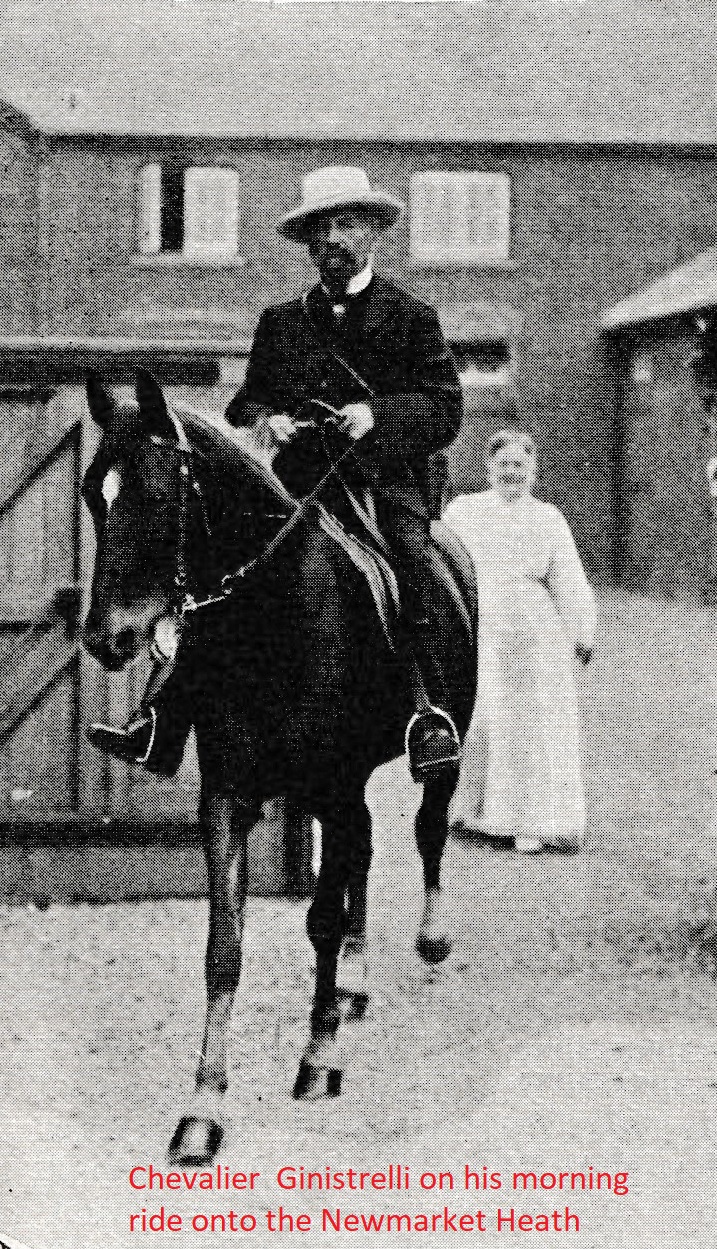

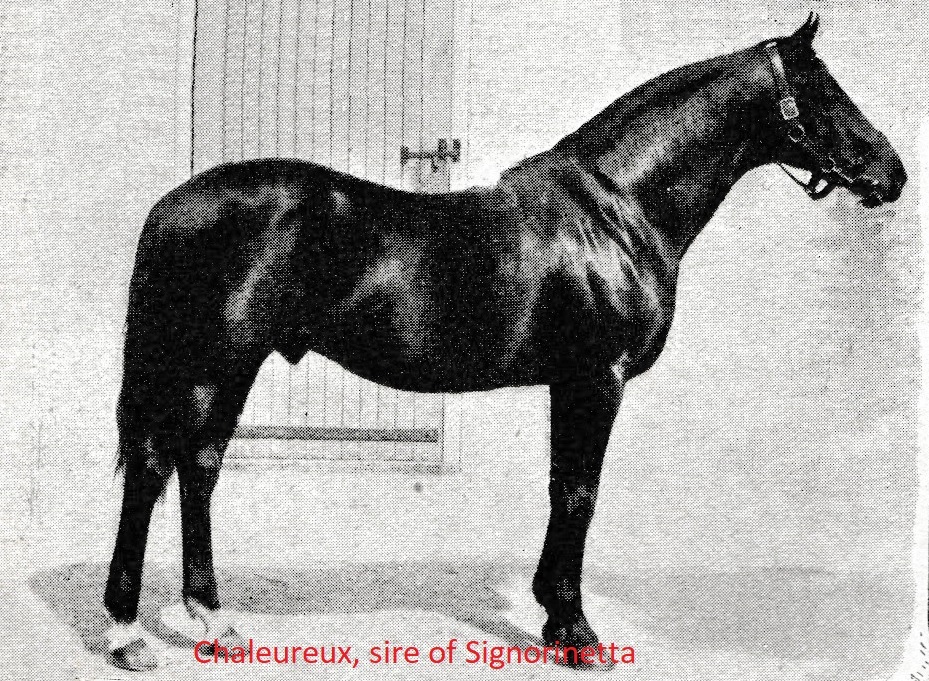
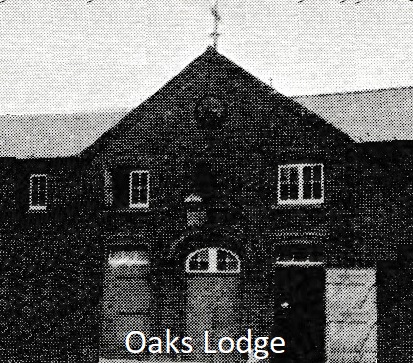
July 1907 Fulbourne Stakes at Newmarket, SIGNORINETTA unplaced at 100/7 behind White Eagle 2/5 fav when ridden by Rickaby
July 1907 National Breeders Produce Stakes at Sandown SIGNORINETTA unplaced at 20/1 behind White Eagle 2/5 fav when partnered by Rickaby
September 1907 A Breeders Foal Plate at Kempton SIGNORINETTA unplaced at 20/1 behind Malheur 2/1 when ridden by F Bullock
October 1907 Newmarket Plate SIGNORINETTA unplaced at 20/1 behind Admiration 4/7 fav when ridden by Rickaby
October 1907 Second Nursery October Stakes at Newmarket SIGNORINETTA unplaced at 20/1 behind Formosa 6/1 when ridden by Heckford
November 1907 Criterion Nursery Handicap at Newmarket SIGNORINETTA 8/1 owned and trained by Chevalier Ginistrelli and ridden by Broadwood
1908 Epsom Derby SIGNORINETTA (SR 1887) 100/1 owned and trained by Chevalier Ginistrelli and ridden by Billy Bullock
1908 Epsom Oaks SIGNORINETTA (SR 1887) 3/1 owned and trained by Chevalier Ginistrelli and ridden by Billy Bullock


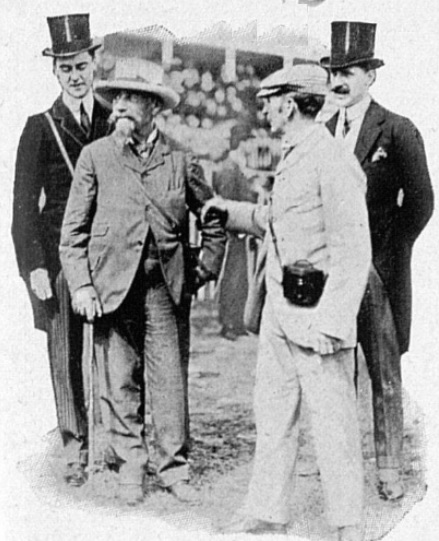
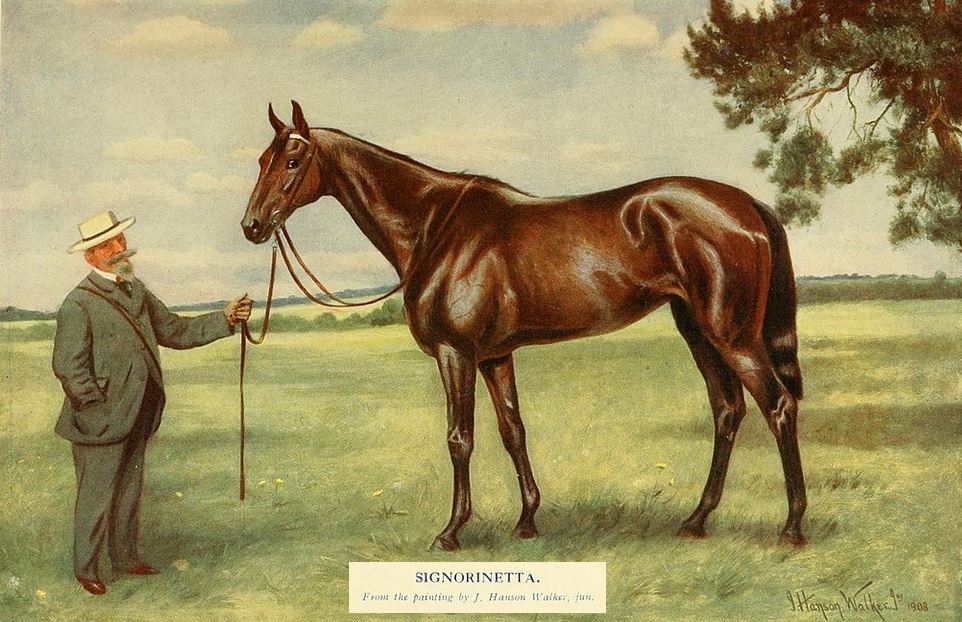
For over 4 centuries racing has been staged in Newmarket, but how have the racecourses evolved from an initial starting point at Fleam Dyke Pumping Station, some 8 miles from the town, with a winning post barely 200 metres from the town centre, into two world recognized, excellent racecourses and a universal acceptance that Newmarket is the Headquarters of racing?
To access an interactive racecourse map showing over 50 individually named racecourses CLICK HERE. The map will enable you to:-
1. Determine when extended races over 8 miles, 6 miles and 4 miles began to be replaced by the courses now visited by thousands annually;
2. Consider how the challenge of crossing the Devil's Dyke was overcome;
3. Contemplate why the town no longer has a steeplechase course despite having at least 5 courses during the past 2 centuries;
4. Examine the practicalities of having up to 48 starting posts and winning posts;
5. Appreciate that it was not financially viable to have an open racecourse spread widely across the heath, with a finishing post barely 200 metres from the town centre;
6. Research how and why the Cambridgeshire Handicap has been contested over 3 different courses.
NOTE: The map does not make mention of 2 particular courses:-
(i) Sefton Course (also known as the Cambridge Road Course)
Source: 1970 Raceform.Used from 1959 to 1975.
(ii) New Circular Course
The Circular Handicap was run on Friday 29th October 1875 on the New Circular Course of about two miles.
Source: London Standard (30th October 1875): ''the horses started near the Turn of the Lands, ran back way of the Cambridgeshire Course towards the Ditch, and afterwards proceeded down the side of the Tan Gallop, and turned into the Rowley Mile near the Bretby Stakes starting post, finishing at the stand at the end of the flat. Except in the hollow near the Cambridgeshire start the runners should have been visible all the way if the sky had been bright and clear''.
Another report hoped that the Circular Handicap would become a feature in future programmes, as it would be contested in front of the new grandstand which would be completed in about a year and would be able to accommodate thousands.
(I am grateful to Tim Cox for bringing attention to these 2 courses.)
Enjoy researching the intriguing history of Newmarket and its many racecourses.
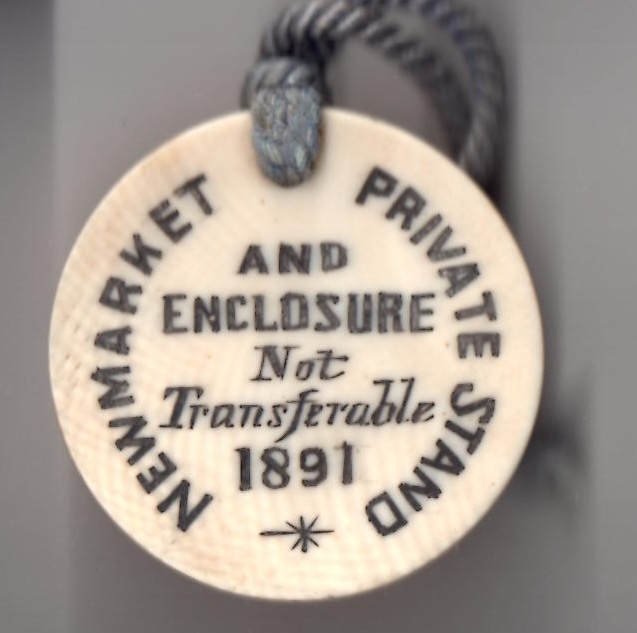
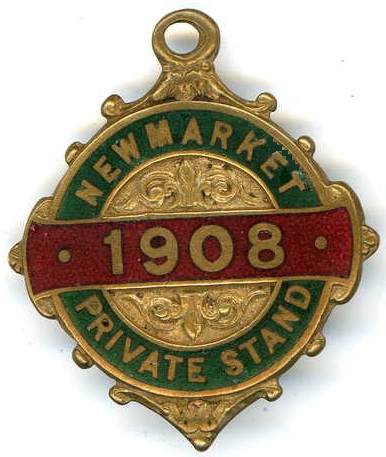
1919-1941 John Bell
John Bell, a trainer at Oaks Lodge, Fordham Road, for over 2 decades, died in Rous Memorial Hospital on Sunday 22nd May 1949 aged 82 and still had 3 racehorses in his charge at the time of his death. He purchased Oaks Lodge from Chevalier Eduardo Ginistrelli in 1919, and was married to Lilian Gertrude Bell for some considerable time until her death on Sunday 20th July 1941 aged 70. The couple were blessed with a daughter, Audrey Bell, who was unmarried at the time of her mother's death, was a sports mistress at Newmarket High School, and a prolific winner of the historic Newmarket Town Plate, partnering Mr Bertrand for Mrs Shafto in 1932, repeating her success two years later aboard her father's owner trained Ravioli, and landed her third victory in the race in 1935 on Lady Gold. John was predominantly an owner trainer, with his most successful horses being Lawn Sand, Only Way, Captain Courageous and Golden Boy, while his favourite course was Redcar.
1941-46 Miss Audrey Bell
When her father John Bell retired from training in the early 1940s, Audrey Bell, of Newmarket Town Plate fame, continued to reside at Oaks Lodge, although the stables were often leased to a variety of trainers.

William Gerard O'Gorman, universally known as Paddy, was born in County Cork, Ireland on 27th May 1913 and travelled across to England in 1934. He transferred to Newmarket after the War to work with Robert 'Jack' Colling, son of the famous trainer Robert Weston Colling, although he had never previously been involved in a formal racing environment, but he proved himself to be an accomplished horseman and was soon put in charge of Colling's Scaltback Stud. He started breaking in yearlings on his own account at Oaks Lodge after the War before moving to Harraton Stables in Exning in 1948, and then next door at Harraton Lodge. In 1953 Paddy successfully applied for a trainer's license, and did well with a small string, winning the 1958 Newbury Spring Cup with Nicholas Nickleby, the 1958 Stewards Cup with Epaulette, and the 1958 King's Stand Stakes with Drum Beat owned by Jack Gerber. Gerber's racing manager Dick Whitford played a significant role in establishing Timeform along with mathematician Phil Bull. Paddy briefly lived in Shalfleet Cottage until the main house was ready in 1959, selling Shalfleet Cottage to John Powney in that year.
1949-1955 L A Westley
For a six-year period in the late 1940s and mid 1950s L A Westley used the facilities at Oaks Lodge to rear hens and produce eggs from his farm. The premises were then taken over by a Caravan company.
April 1955 onwards Mr Alperson
In April 1955 the West Suffolk County Council approved an application by Messrs Alperson for Oaks Lodge to be used as a caravan factory and centre for their wholesale Caravan business.



